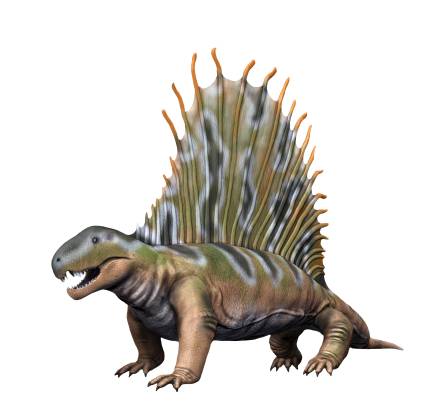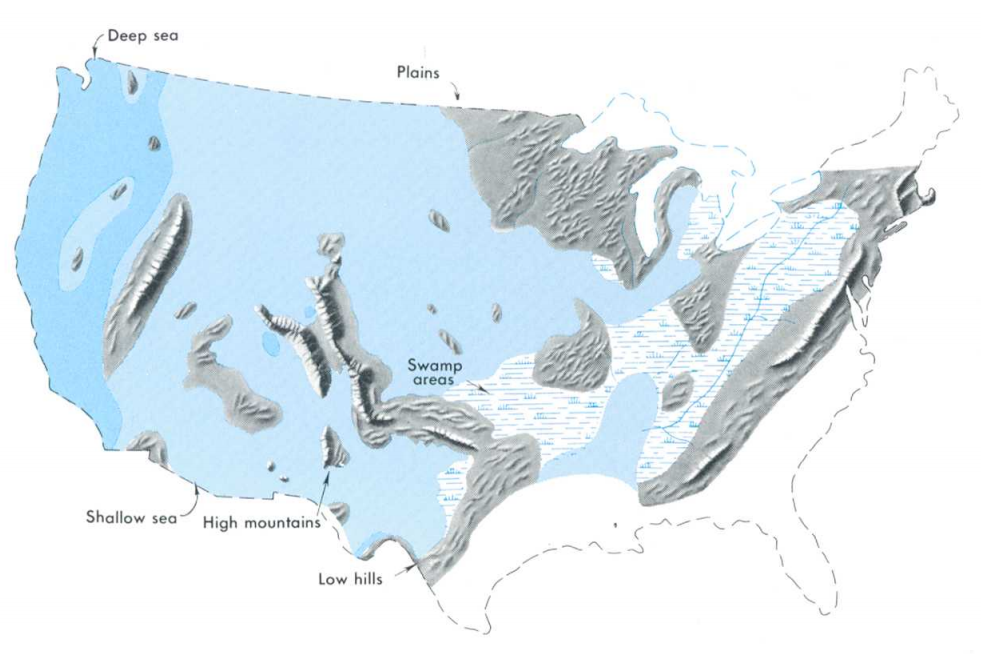|
Pelycosaurs
Pelycosaur ( ) is an older term for basal or primitive Late Paleozoic synapsids, excluding the therapsids and their descendants. Previously, the term mammal-like reptile was used, and Pelycosauria was considered an order, but this is now thought to be incorrect and outdated. Because it excludes the advanced synapsid group Therapsida, the term is paraphyletic and contrary to modern formal naming practice. Thus the name ''pelycosaurs'', similar to the term ''mammal-like reptiles'', fell out of favor among scientists by the 21st century, and is only used informally, if at all, in the modern scientific literature. The terms stem mammals, protomammals, and basal or primitive synapsids are instead used where needed. Etymology The modern word was created from Greek meaning 'basin' and meaning 'lizard'. The term ''pelycosaur'' has been fairly well abandoned by paleontologists because it no longer matches the features that distinguish a clade. Pelycosauria is a paraphyletic ... [...More Info...] [...Related Items...] OR: [Wikipedia] [Google] [Baidu] |
Eupelycosauria
Eupelycosauria is a large clade of animals characterized by the unique shape of their skull, encompassing all mammals and their closest extinct relatives. They first appeared 308million years ago during the Early Pennsylvanian epoch, with the fossils of '' Echinerpeton'' and perhaps an even earlier genus, '' Protoclepsydrops'', representing just one of the many stages in the evolution of mammals,Kemp. T.S., 1982, ''Mammal-like Reptiles and the Origin of Mammals''. Academic Press, New York in contrast to their earlier amniote ancestors. Taxonomy Eupelycosaurs are synapsids, animals whose skull has a single opening behind the eye. They are distinguished from the Caseasaurian synapsids by having a long, narrow supratemporal bone (instead of one that is as wide as it is long) and a frontal bone with a wider connection to the upper margin of the orbit. Laurin, M. and Reisz, R. R., 1997Autapomorphies of the main clades of synapsids- Tree of Life Web Project The only living descen ... [...More Info...] [...Related Items...] OR: [Wikipedia] [Google] [Baidu] |
Therapsida
Therapsida is a clade comprising a major group of eupelycosaurian synapsids that includes mammals and their ancestors and close relatives. Many of the traits today seen as unique to mammals had their origin within early therapsids, including limbs that were oriented more underneath the body, resulting in a more "standing" quadrupedal posture, as opposed to the lower sprawling posture of many reptiles and amphibians. Therapsids evolved from earlier synapsids commonly called " pelycosaurs", specifically within the Sphenacodontia, more than 279.5 million years ago. They replaced the pelycosaurs as the dominant large land animals in the Guadalupian through to the Early Triassic. In the aftermath of the Permian–Triassic extinction event, therapsids declined in relative importance to the rapidly diversifying archosaurian sauropsids (pseudosuchians, dinosaurs and pterosaurs, etc.) during the Middle Triassic. The therapsids include the cynodonts, the group that gave rise to mammal ... [...More Info...] [...Related Items...] OR: [Wikipedia] [Google] [Baidu] |
Dimetrodon
''Dimetrodon'' ( or ; ) is an extinct genus of sphenacodontid synapsid that lived during the Cisuralian (Early Permian) Epoch (geology), epoch of the Permian period, around 295–272 million years ago. With most species measuring long and weighing , the most prominent feature of ''Dimetrodon'' is the large neural spine sail on its back formed by elongated spines extending from the vertebrae. It was an obligate Quadrupedalism, quadruped (it could walk only on four legs) and had a tall, curved skull with large teeth of different sizes set along the jaws. Most fossils have been found in the Southwestern United States, the majority of these coming from a geological deposit called the Red Beds of Texas and Oklahoma. More recently, its fossils have also been found in Germany and over a dozen species have been named since the genus was first erected in 1878. ''Dimetrodon'' is often mistaken for a dinosaur or portrayed as a contemporary of dinosaurs in popular culture, but it beca ... [...More Info...] [...Related Items...] OR: [Wikipedia] [Google] [Baidu] |
Varanopidae
Varanopidae is an extinct family (biology), family of amniotes known from the Late Carboniferous to Middle Permian that resembled monitor lizards (with the name of the group deriving from the monitor lizard genus ''Varanus'') and may have filled a similar niche. Typically, they are considered to be relatively Basal (phylogenetics), basal Synapsida, synapsids (and thus more closely related to mammals than to reptiles), although some studies from the late 2010s recovered them being taxonomically closer to diapsid reptiles, recent studies from the early 2020s support their traditional placement as synapsids on the basis of high degree of bone labyrinth ossification, maxillary canal morphology and phylogenetic analyses. A varanopid from the late Middle Permian Pristerognathus Assemblage Zone, ''Pristerognathus'' Assemblage Zone (Capitanian) is the youngest known varanopid and the last member of the "pelycosaur" group of synapsids. Thus, Varanopidae vanishes from the fossil record at th ... [...More Info...] [...Related Items...] OR: [Wikipedia] [Google] [Baidu] |
Mammal
A mammal () is a vertebrate animal of the Class (biology), class Mammalia (). Mammals are characterised by the presence of milk-producing mammary glands for feeding their young, a broad neocortex region of the brain, fur or hair, and three Evolution of mammalian auditory ossicles, middle ear bones. These characteristics distinguish them from reptiles and birds, from which their ancestors Genetic divergence, diverged in the Carboniferous Period over 300 million years ago. Around 6,640 Neontology#Extant taxon, extant species of mammals have been described and divided into 27 Order (biology), orders. The study of mammals is called mammalogy. The largest orders of mammals, by number of species, are the rodents, bats, and eulipotyphlans (including hedgehogs, Mole (animal), moles and shrews). The next three are the primates (including humans, monkeys and lemurs), the Artiodactyl, even-toed ungulates (including pigs, camels, and whales), and the Carnivora (including Felidae, ... [...More Info...] [...Related Items...] OR: [Wikipedia] [Google] [Baidu] |
Synapsid
Synapsida is a diverse group of tetrapod vertebrates that includes all mammals and their extinct relatives. It is one of the two major clades of the group Amniota, the other being the more diverse group Sauropsida (which includes all extant reptiles and therefore, birds). Unlike other amniotes, synapsids have a single temporal fenestra, an opening low in the skull roof behind each eye socket, leaving a zygomatic arch, bony arch beneath each; this accounts for the name "synapsid". The distinctive temporal fenestra developed about 318 million years ago during the Late Carboniferous period, when synapsids and sauropsids diverged, but was subsequently merged with the orbit in early mammals. The basal (phylogenetics), basal amniotes (reptiliomorphs) from which synapsids evolved were historically simply called "reptiles". Therefore, stem group synapsids were then described as mammal-like reptiles in classical systematics, and non-therapsid synapsids were also referred to as pelyco ... [...More Info...] [...Related Items...] OR: [Wikipedia] [Google] [Baidu] |
Ophiacodontidae
Ophiacodontidae is an extinct family of early synapsids from the Carboniferous and Permian. '' Archaeothyris'', and '' Clepsydrops'' were among the earliest ophiacodontids, appearing in the Late Carboniferous. Ophiacodontids are among the most basal synapsids, an offshoot of the lineage which includes therapsids and their descendants, the mammals. The group became extinct by the Kungurian or the Roadian, replaced by anomodonts, theriodonts, and the diapsid reptiles. Characteristics The lifestyle of ophiacodonts has long been controversial. Some studies suggested that they were semi-aquatic, and some even suggested a fairly aquatic lifestyle, but a recent study based on a quantitative inference model suggested that both '' Clepsydrops'' and '' Ophiacodon'' were terrestrial. Vertebral morphometric data also support, though ambiguously, a rather terrestrial lifestyle for '' Ophiacodon'', which could reach a length of . '' Archaeothyris'' may also have been terrestrial, but no ... [...More Info...] [...Related Items...] OR: [Wikipedia] [Google] [Baidu] |
Sphenacodontidae
Sphenacodontidae (Greek: "wedge point tooth family") is an extinct family (biology), family of sphenacodontoidea, sphenacodontoid synapsids. Small to large, advanced, carnivore, carnivorous, Late Pennsylvanian to Guadalupian, middle Permian "pelycosaurs". The most recent one, ''Dimetrodon angelensis'', is from the latest Kungurian or, more likely, early Roadian San Angelo Formation. However, given the notorious incompleteness of the fossil record, a recent study concluded that the Sphenacodontidae may have become extinct as recently as the early Capitanian. Primitive forms were generally small (60 cm to 1 meter), but during the later part of the Cisuralian, early Permian these animals grew progressively larger (up to 3 meters or more), to become the Apex predator, top predators of terrestrial environments. Sphenacodontid fossils are so far known only from North America and Europe. Characteristics The skull is long, deep and narrow, an adaptation for strong jaw muscles. The f ... [...More Info...] [...Related Items...] OR: [Wikipedia] [Google] [Baidu] |
Permian
The Permian ( ) is a geologic period and System (stratigraphy), stratigraphic system which spans 47 million years, from the end of the Carboniferous Period million years ago (Mya), to the beginning of the Triassic Period 251.902 Mya. It is the sixth and last period of the Paleozoic Era; the following Triassic Period belongs to the Mesozoic Era. The concept of the Permian was introduced in 1841 by geologist Sir Roderick Murchison, who named it after the Perm Governorate, region of Perm in Russia. The Permian witnessed the diversification of the two groups of amniotes, the synapsids and the Sauropsida, sauropsids (reptiles). The world at the time was dominated by the supercontinent Pangaea, which had formed due to the collision of Euramerica and Gondwana during the Carboniferous. Pangaea was surrounded by the superocean Panthalassa. The Carboniferous rainforest collapse left behind vast regions of desert within the continental interior. Amniotes, which could better cope with these ... [...More Info...] [...Related Items...] OR: [Wikipedia] [Google] [Baidu] |
Pennsylvanian (geology)
The Pennsylvanian ( , also known as Upper Carboniferous or Late Carboniferous) is, on the International Commission on Stratigraphy, ICS geologic timescale, the younger of two period (geology), subperiods of the Carboniferous Period (or the upper of two system (stratigraphy), subsystems of the Carboniferous System). It lasted from roughly . As with most other geochronology, geochronologic units, the stratum, rock beds that define the Pennsylvanian are well identified, but the exact date of the start and end are uncertain by a few hundred thousand years. The Pennsylvanian is named after the U.S. state of Pennsylvania, where the coal Bed (geology), beds of this age are widespread. The division between Pennsylvanian and Mississippian (geology), Mississippian comes from North American stratigraphy. In North America, where the early Carboniferous beds are primarily marine limestones, the Pennsylvanian was in the past treated as a full-fledged geologic period between the Mississippian ... [...More Info...] [...Related Items...] OR: [Wikipedia] [Google] [Baidu] |
Caseasauria
Caseasauria is one of the two main clades of early synapsids, the other being the Eupelycosauria. Caseasaurs are currently known only from the Late Carboniferous and the Permian, and include two superficially different families, the small insectivorous or carnivorous Eothyrididae, and the large, herbivory, herbivorous Caseidae. These two groups share a number of specialised features associated with the morphology of the snout and external nares, naris. The ancestor of caseasaurs can be traced back to an insect eating or an omnivorous reptile-like synapsid from the Pennsylvanian (geology), Pennsylvanian time of the Carboniferous, possibly resembling ''Archaeothyris'', the earliest known synapsid. The caseasaurs were abundant during the later part of the Early Permian, but by the Middle Permian caseasaur diversity declined because the group was outcompeted by the more successful therapsids. The last caseasaurs became extinct at the end of the Guadelupian (Middle Permian). Descript ... [...More Info...] [...Related Items...] OR: [Wikipedia] [Google] [Baidu] |






